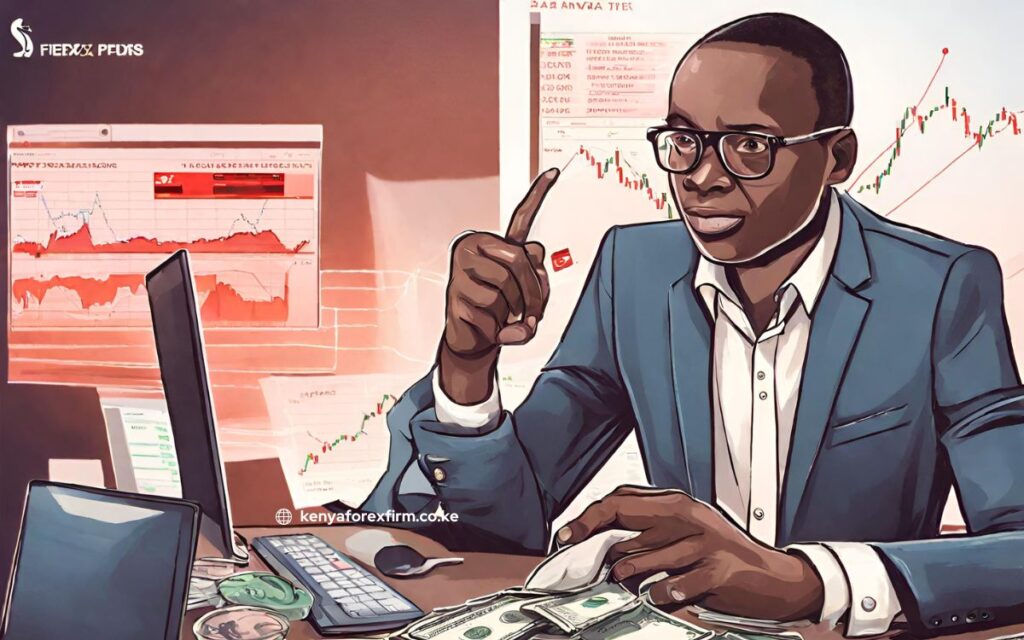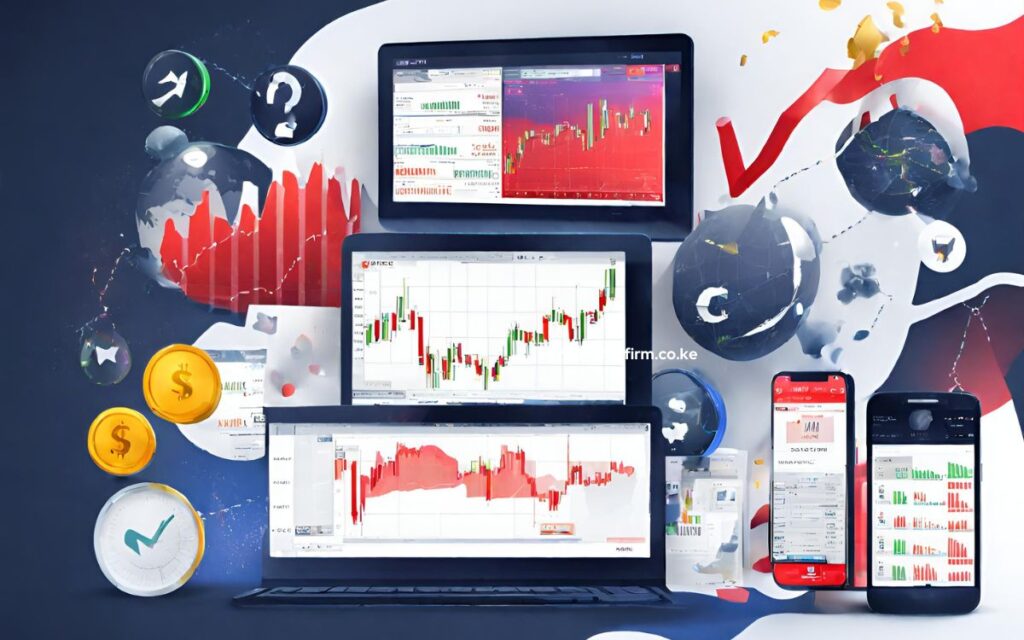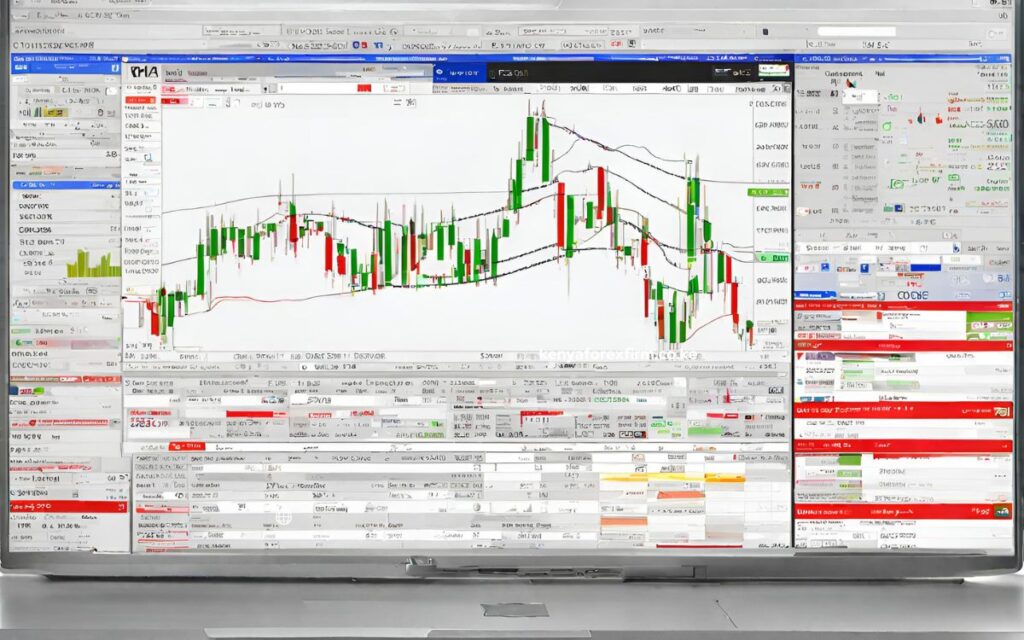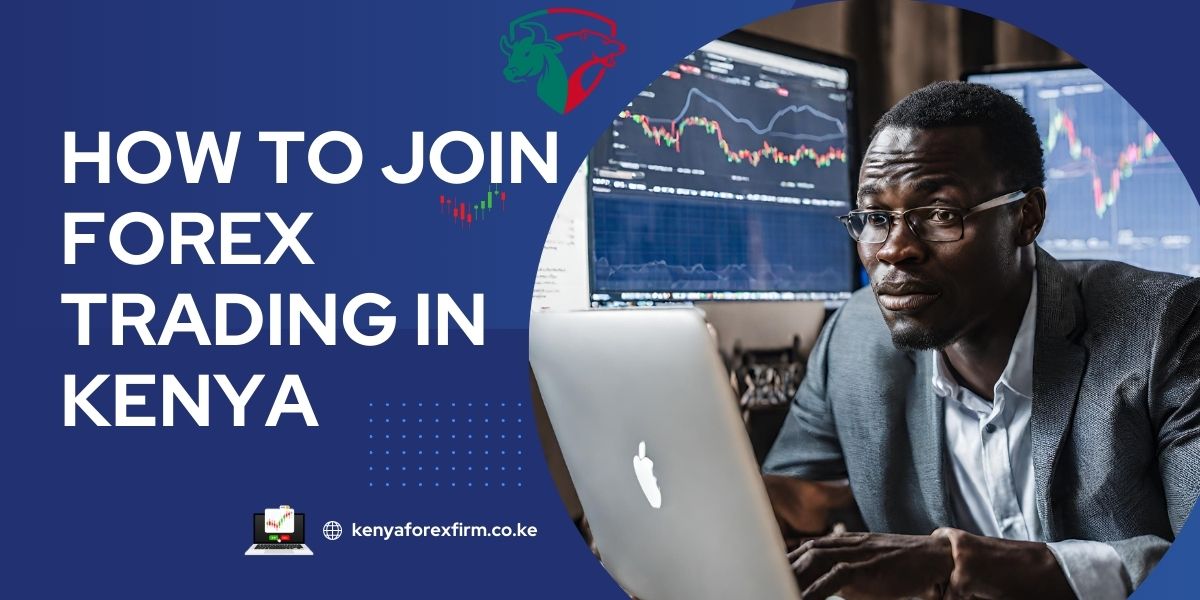Are you ready to dive into the exhilarating, fast-paced universe of forex trading? Buckle up, because today, we’re embarking on a thrilling journey to unlock the secrets of ‘How to Join Forex Trading in Kenya’.
- Get a Forex Trading Device with Internet Connectivity
- Find a Forex Broker That Accepts Clients From Kenya
- Open a Forex Trading Account in Kenya
- Make a Deposit Using M-Pesa
- Download the Forex Broker's Trading Platform
- Placing Your First Forex Trade
- Best Time to Trade Forex in Kenya
- How Much Do You Need to Start Forex Trading in Kenya
- How Much Can You Make Trading Forex in Kenya?
- Conclusion: How to Join Forex Trading in Kenya
This isn’t just about numbers and charts; it’s about tapping into an opportunity that could transform your financial future! Forex trading, with its 24-hour market and massive liquidity, has been making waves globally, and Kenya hasn’t been left behind.
More and more Kenyans are stepping into this dynamic arena, eager to learn, trade, and potentially reap substantial rewards. But how exactly do you get started? What are the steps you need to take to join this vibrant community of traders? In this article, we’ll demystify the process, guiding you through every step of the way.
Join the Copy Trading Revolution
Copy the trades of successful Forex traders and profit from their strategies.
*Forex and CFDs Trading involves high risk. T&Cs apply.
From understanding the basics of forex trading to choosing the right forex broker, we’ve got you covered. So, whether you’re a seasoned trader looking to expand your horizons or a complete beginner ready to take your first step, this guide is your ticket to joining the exciting world of forex trading in Kenya. Stay tuned, because we’re about to embark on an adventure that could change your life!
Our comprehensive guide will show you how to join forex trading in Kenya. You’ll learn how the market works, how to open an account, effective trading techniques, and how to avoid common mistakes.
By the end of this guide, you’ll know how to open your trading account, develop effective trading plans, and embark on your journey to forex success in Kenya. Sound exciting? Then let’s begin!
Show Summary
To join forex trading in Kenya, you need to follow several steps:
- Get a device with internet connectivity: This could be a smartphone, tablet, or computer.
- Find an online forex broker that accepts clients from Kenya: Many online forex brokers accept Kenyan clients. Make sure to choose a broker that is licensed and regulated by the Capital Markets Authority (CMA) to ensure the safety of your funds and compliance with regulations.
- Open a margin account with the broker for trading forex: This involves visiting the broker’s website and following the instructions to open a trading account.
- Make a deposit using a payment method accepted by the broker: The deposit will serve as your trading capital. It’s advisable to start with a small investment.
- Download the broker’s proprietary trading platform or a platform you can use with that broker: This is the platform you will use to execute your trades.
- Make your first trade: Before you start trading, it’s crucial to develop a trading plan that includes a profitable trading strategy to increase your chances of success. You can also consider copying a successful trader’s transactions via a social trading platform if you are new to trading.
Remember, forex trading comes with high risks, so it’s essential to know how to minimize these risks. Some risk reduction strategies you could apply when trading include limiting your leverage or setting a stop-loss order.
It’s also important to educate yourself about the markets, including fundamental and technical analysis, as well as trading strategies and risk management techniques.
Many brokers offer educational resources, such as webinars and tutorials, to help traders improve their skills and knowledge.
Lastly, always consult a professional financial advisor or investment professional to help you get started
Get a Forex Trading Device with Internet Connectivity

The first step is to get a device with reliable internet connectivity. This will allow you to access online forex brokers and trading platforms.
Forex trading requires a reliable device that can handle the demands of real-time trading. This could be a desktop computer, a laptop, or a smartphone. The choice depends on your personal preferences, budget, and trading style.
A laptop is one of the most popular devices for forex trading in Kenya. The larger screen size makes it easier to analyze charts and place trades. Most laptops today come with built-in wifi connectivity so you can access the internet from anywhere. Some key things to look for in a forex trading laptop are:
- Processor – An Intel Core i5 or equivalent is recommended for smooth performance
- RAM – 8GB or higher for multitasking capabilities
- Storage – An SSD rather than HDD for faster performance
- Display – 1920×1080 resolution or higher for detailed charts
You need a laptop that can handle the demands of forex trading. This means a powerful processor, ample RAM, and a fast SSD. Look for laptops with at least an Intel Core i5 or AMD Ryzen 5 processor, 8GB of RAM, and a 256GB SSD. These specs will ensure smooth and efficient trading, even when you’re running multiple trading platforms and analyzing complex charts.
Some good budget laptop options include HP Pavilion 15 and Lenovo IdeaPad 3.
If you’re always on the go, a smartphone could be your best bet. Most modern smartphones can handle forex trading apps. Just ensure that the phone has a good processor, enough storage, and a reliable internet connection.
Find a Forex Broker That Accepts Clients From Kenya

-
A forex broker is a financial services company that provides access to the global forex market. They act as an intermediary between traders and liquidity providers such as banks.
When you want to buy or sell a currency pair like EUR/USD, you place the trade through your broker's trading platform. The broker will execute the trade on your behalf, charging a small commission or spread on each trade.
Forex brokers provide services like:
- Access to trading platforms and analysis tools
- Leverage to increase your trading size
- Customer support and education for new traders
- Secure storage of your funds in segregated accounts
The forex broker you choose can make a significant difference in your trading experience. A good broker provides a reliable platform, competitive fees, and excellent customer service. They should also offer a demo account feature, which allows you to practice trading with virtual money before you start investing real money
How to Pick the Right Forex Broker in Kenya
- Regulation – Select a broker regulated by a major authority like the UK’s FCA or Australia’s ASIC. This helps ensure the safety of your funds. In Kenya, the Capital Markets Authority (CMA) is responsible for regulating forex brokers.
- Trading platforms – Forex brokers offer platforms like MT4, MT5, and cTrader. Choose a broker that offers a platform you find easy to use.
- Fees and Charges: Forex brokers earn their income through fees and charges (spreads or commissions). Check the broker’s fee structure and compare it with other brokers
- Customer support – Test customer support by contacting them. See if they quickly respond to queries and are knowledgeable. This is important when you need trading assistance. Pick a broker with 24/5 support via live chat, email, or phone.
- Funding and withdrawals – The broker should support M-Pesa, bank transfers, cards, and e-wallets. Also, consider any deposit/withdrawal fees charged. Some brokers offer free deposits and withdrawals.
- Read Reviews and Testimonials: Don’t just take my word for it! Read reviews and testimonials from other forex traders in Kenya to get a well-rounded view of the broker’s services and reputation.
Top Forex Brokers in Kenya
- Exness: This global brokerage sensation offers a diverse range of account types, including Standard, Raw Spread, and Zero accounts, catering to traders of all levels. Their lightning-fast execution and competitive spreads make them a top choice.
- IC Markets: If you’re a seasoned trader seeking razor-sharp spreads and a wide selection of trading instruments, IC Markets is your go-to broker. Their Raw Spread account offers spreads as low as 0.0 pips, making them a favorite among experienced traders.
- Pepperstone: Pepperstone has carved a niche for itself with its ultra-low spreads, starting from 0.0 pips, and its user-friendly trading platforms. Their commitment to providing top-notch customer service and educational resources makes them a popular choice among Kenyan traders.
Some recommended regulated brokers that accept Kenyans include Exness, Pepperstone, HFM, and XM. Once you’ve chosen a suitable broker, simply visit their website and sign up for a demo account to start testing their platform.
Open a Forex Trading Account in Kenya

The process of opening a forex account in Kenya is incredibly straightforward. Simply choose a reputable forex broker that is regulated by the Capital Markets Authority (CMA) of Kenya.
Once you’ve found a broker that meets your needs, you can easily create an account online in just a few minutes.
This is a crucial step in your journey to becoming a forex trader. But what exactly is a forex trading account, and how do you go about opening one?
- A margin account allows you to trade larger positions than your account balance would normally allow by using leverage provided by the broker. For example, if you have $1,000 in your account and the broker offers 50:1 leverage, you can control trades worth $50,000.
Opening a forex trading account is a straightforward process that anyone can do, regardless of their computer skills. Here’s a step-by-step guide:
- Choose the Account Type: Based on your risk tolerance, initial investment size, and trading experience, choose the type of account that suits you best. If you’re a beginner, a mini account or a demo account (which uses virtual money for risk-free practice) might be a good start.
- Complete the Application Form: Visit the broker’s website and fill out the application form. You’ll need to provide personal information and details about your financial status and investment experience.
- Submit Required Documents: You may need to submit identification documents for verification purposes. This could include a copy of your national ID, driver’s license, or other forms of ID, as well as proof of address such as an M-Pesa statement.
The account opening process is fully digital and can be completed in minutes. You will receive login details for your new trading account via email.
Make a Deposit Using M-Pesa

You have now opened your forex trading account with a regulated broker in Kenya. The next step is to fund your account by making your first deposit. This deposit acts as your trading capital which allows you to start buying and selling currencies.
-
A forex deposit refers to the initial capital you transfer into your trading account to start live trading. It is the money you will use to buy and sell currency pairs. The deposit gives you trading leverage based on your account type.
While you can start small, consider depositing between $100 to $500 if you're a beginner. This gives you enough trading capital while minimizing risk exposure as you learn the basics.
The minimum deposit amount varies across different forex brokers. Some brokers allow you to open an account with as little as $1 or $5. However, a deposit between $100 to $300 is more reasonable for beginners. This gives you enough capital to trade while minimizing risks.
Some brokers like Exness have a minimum deposit of around 10 USD when depositing in US dollars. If depositing in Kenyan Shillings, the minimum amount may differ slightly due to currency conversion rates.
Most forex brokers accept local and international payment methods. This includes:
- Credit/Debit Cards like Visa and Mastercard. This allows instant deposits.
- Mobile Money like M-Pesa, Airtel Money, T-Kash etc. Convenient for local Kenyan traders.
- Bank Wire Transfer directly from your bank account. May take 1-3 days.
- Online Wallets like Skrill, Neteller, PayPal etc. Deposits are instant.
- Cryptocurrency like BTC, ETH, LTC etc. if your broker supports it.
Always check your broker’s website for the full list of payment options, and remember, it’s important to only deposit what you can afford to lose. Forex trading involves significant risk, and it’s possible to lose your entire deposit if trades go against you.
Download the Forex Broker's Trading Platform

After you have deposited money into your forex trading account, the next step is to download the broker’s trading platform to your computer or mobile device. The trading platform is the software you will use to analyze the markets and execute trades.
- A trading platform is the software interface provided by brokers for clients to monitor market data and execute trading orders. The platform shows updated currency prices, charts, technical indicators, trading tools, order types, account balances, statements, and more.
The most popular forex trading platforms are MetaTrader 4 (MT4) and MetaTrader 5 (MT5). These platforms are offered by most brokers and have advanced charting capabilities, a wide range of technical indicators, and support for Expert Advisors (EAs) for automated trading. However, many brokers also offer their own custom platforms, like FOREX.com’s Advanced Trader platform.
- As a beginner, you’ll want a platform that is intuitive and easy to navigate.
- Look for platforms that allow you to easily execute trades with just a few clicks, as well as view live market prices and customize charts.
- Avoid platforms that seem overly complex.
Some brokers also offer browser-based web trading platforms or mobile trading apps on iOS and Android. These can be easily accessed online or installed from app stores without needing downloads or installations.
After downloading the platform, take some time to familiarize yourself with its features. Look for the following key features:
- Trade execution: This is where you’ll place your buy and sell orders.
- Real-time quotes: These will show you the current prices of currency pairs.
- Charting tools: These will help you analyze market trends and make informed trading decisions.
- Account management: This is where you’ll monitor your account balance, margin, profits, and losses
With the broker’s trading platform installed, you have all the tools needed to start analyzing forex charts and placing trades.
The next step is to develop your trading strategy and place your first trade. This will require analyzing currency pairs, identifying profitable opportunities based on your strategy, and managing the trade through to completion.
Placing Your First Forex Trade

Congratulations! You’ve made it to the exciting part of your forex trading journey. Now that you’ve downloaded your broker’s trading platform and have a funded account, it’s time to make your first trade. In this step, we’ll walk you through the process of executing a trade successfully.
- Forex trading involves buying one currency and selling another simultaneously. Currency pairs are the foundation of forex trading, and they represent the value of one currency relative to another. Some of the most traded currency pairs include EUR/USD (Euro/US Dollar), USD/JPY (US Dollar/Japanese Yen), and GBP/USD (British Pound/US Dollar).
First, open the MT4 platform on your device. You should see a screen with various charts and tools. Don’t be overwhelmed; we’ll go through the important parts.
Before placing a trade, it’s essential to analyze the market and make informed decisions. You can use technical analysis, which involves studying price charts and historical data, or fundamental analysis, which focuses on economic indicators and news events that may affect currency values.
For instance, you might notice that the EUR/USD pair has been in an uptrend, and you believe it will continue to rise. Based on your analysis, you decide to buy the EUR/USD pair, expecting the Euro to appreciate against the US Dollar.
To buy the EUR/USD pair, you’ll place a “buy” order at the ask price. For example, if the ask price is 1.1200, you’ll buy one Euro for 1.1200 US Dollars. Once your order is executed, you’ll have an open position in the EUR/USD pair.
To manage risk and protect your investment once your trading is running, it’s crucial to set stop loss and take profit orders.
- A stop loss is an order that automatically closes your position if the market moves against you by a certain amount, limiting your potential loss.
- On the other hand, a take profit order automatically closes your position when the market moves in your favor by a specified amount, locking in your gains.
For example, you might set a stop loss order at 1.1150, which would limit your loss to 50 pips if the EUR/USD pair declines. You could also set a take profit order at 1.1300, locking in a profit of 100 pips if the pair rises to that level.
Now that you’ve chosen your currency pair, and lot size, and set your stop loss and take profit levels, it’s time to place your trade. To do this, open your trading platform and enter a buy or sell order for your chosen currency pair.
For example, if you believe the EUR/USD will rise, you would enter a buy order. Conversely, if you think the EUR/USD will fall, you will enter a sell order.
Once your trade is open, it’s essential to monitor its progress and make any necessary adjustments. This may involve moving your stop loss or take profit levels, or even closing your position early if the market conditions change.
Regardless of the outcome, keeping a trading journal is vital. Record details like your entry/exit prices, stop loss levels, and what worked or didn’t for next time. Review these notes later to improve.
Take the time to review and analyze the outcome of your first trade. What went well? What could have been done differently? Use this information to refine your trading strategy and improve your future trades.
Best Time to Trade Forex in Kenya
The forex market operates 24 hours a day, five days a week, following the sun. As a result, different trading sessions occur as financial centers open and close worldwide. The three primary trading sessions are:
- Asian Session (Tokyo): 12:00 AM – 8:00 AM Nairobi Time (EAT)
- London Session: 8:00 AM – 5:00 PM EAT
- New York Session: 1:00 PM – 10:00 PM EAT
For traders in Kenya, the best time to trade forex is during the overlap of the London and New York sessions. For Kenyan traders, the magic happens between 11:00 AM and 5:00 PM East Africa Time (EAT). This is when the London and New York markets are both active, and the trading action heats up. During this period, market liquidity is at its peak, providing tighter spreads and faster execution.
Why is this time frame so special, you ask? Well, the London and New York markets are two of the biggest players in the forex game. When they’re both open, the volume of trading spikes, leading to bigger price movements and more opportunities to make a profit
Additionally, this time zone aligns with the release of high-impact economic news and data from major economies, potentially leading to increased volatility and trading opportunities.
But wait, there’s more! If you’re a night owl, or if you prefer trading when volatility is high, you might want to look beyond this timeframe. The Tokyo market opens at 9:00 AM and closes at 6:00 PM, offering another window of opportunity.
Beyond market liquidity and trading sessions, several other factors can influence your trading decisions:
- Trading Style: Scalpers and day traders who hold positions for a short duration may prefer the high volatility and liquidity of the overlap sessions. In contrast, swing traders and long-term investors might find opportunities throughout the day.
- Currency Pairs: The liquidity and volatility of currency pairs vary. Major pairs like EUR/USD and GBP/USD tend to be more liquid and volatile, while exotic pairs may have lower liquidity and higher spreads.
- Risk Tolerance: Traders with a higher risk tolerance may prefer trading during volatile periods, while those with a lower risk tolerance might opt for quieter times.
understanding the best time to trade forex in Kenya is essential for maximizing profitability. By considering factors such as market liquidity, time zone differences, and economic news releases, you can optimize your trading strategies and minimize risks. Check out our guide on the forex trading sessions in Kenyan time.
How Much Do You Need to Start Forex Trading in Kenya
The amount of capital needed to start forex trading in Kenya varies widely. It depends on factors such as your risk tolerance, trading strategy, and the broker you choose.
However, many forex brokers in Kenya allow you to open an account with as little as $10 (approximately 1,100 Kenyan Shillings) while others might ask for more. But it’s not just about the minimum deposit; it’s also about what you’re comfortable with and how you manage your risks.
But let’s be clear: while it’s possible to start with a small amount, it might not be sufficient to see significant profits. To make a meaningful income from forex trading, you might need to invest more.
Some experienced traders suggest starting with at least $1,000 (approximately 110,000 Kenyan Shillings).
Factors Influencing Capital Needs
While the minimum capital requirement provides a baseline, the actual amount of capital you need to start forex trading in Kenya depends on several factors:
- Trading Strategy: Your trading strategy, whether scalping, day trading, or swing trading, influences your capital requirements. Scalping and day trading, involving frequent trades, demand larger capital to accommodate potential losses.
- Risk Tolerance: Your risk tolerance, the level of financial loss you’re comfortable with, also plays a role. Higher risk tolerance allows for smaller capital, as you’re willing to accept larger potential losses.
- Leverage: Leverage, the ability to control a larger position with a smaller amount of capital, is a double-edged sword. While it can magnify profits, it can also amplify losses. Using leverage judiciously is crucial to managing risk and preserving capital.
- Trading Volume: The volume of trades you intend to execute impacts your capital needs. Higher trading volumes necessitate larger capital to cover potential losses and maintain sufficient margin.
How Much Can You Make Trading Forex in Kenya?
You’re probably wondering, “How much do forex traders earn in Kenya?” Well, you’re in for a surprise! The answer is not as straightforward as you might think, but don’t worry, we’ll break it down for you.
Forex trading is a game of numbers, and the earnings can vary widely. For some, it’s a full-time job, while for others, it’s a side hustle to supplement their income.
For the average Forex trader in Kenya, the monthly salary can range from KES 30,038 to KES 300,435.
However, these figures can fluctuate depending on the trader’s skill level, strategy, and market conditions.
For instance, a beginner trader might make a few hundred Kenyan shillings a day, while an experienced trader could rake in thousands.
According to Glassdoor statistics, in 2023, the average day trader in Kenya could earn 200,000 KES per month or 6,400 KES per day.
Let’s look at some of the successful forex traders in Kenya and how much they make. These individuals have not only made a name for themselves in the forex trading industry but also serve as an inspiration for aspiring traders.
- Patrick Mahinge: Patrick is the founder of Kenya Forex Firm, which provides training and portfolio management services for forex traders in Kenya. He is one of the richest forex traders in Kenya and has earned a significant amount of money through forex trading.
- Ken Githaiga: Ken has been trading on the forex market since leaving college in 2008. His success story serves as an inspiration for many young Kenyans looking to venture into forex trading.
- Paul Mugenda: Paul is another successful forex trader in Kenya. His success in the forex market has made him a role model for many aspiring traders in the country.
- Silah Obegi: Silah is a renowned forex trader in Kenya. His success in the forex market has earned him a spot among the top forex traders in the country.
- Sylvia Muchai: Sylvia is the founder of Sylvia’s Traders Lounge, which helps members develop strategies to be successful as financial traders. She started trading on the forex markets in 2014 with a $250 trading account and has since become one of the most successful traders in the country.
Conclusion: How to Join Forex Trading in Kenya
- Understand the Basics of Forex Trading: Before you dive into forex trading, it’s essential to understand the basics. This includes learning about currency pairs, bid-ask spreads, leverage, and trading platforms. You can find plenty of resources online and through forex brokers that offer educational materials for beginners.
- Choose a Reliable Forex Broker: Choosing a reliable and regulated forex broker is crucial for your trading success. Look for a broker that is licensed by the Capital Markets Authority (CMA) of Kenya and offers competitive trading conditions, such as low spreads and fast execution speeds.
- Open a Forex Trading Account: Once you’ve chosen a broker, you’ll need to open a forex trading account. This typically involves providing personal information, such as your name, address, and identification documents. You’ll also need to deposit funds into your account to start trading.
- Set Realistic Trading Goals: Before you start trading, it’s important to set realistic trading goals. This will help you stay focused and avoid making impulsive decisions. Your goals should be specific, measurable, achievable, relevant, and time-bound (SMART).
- Develop a Trading Strategy: A trading strategy is a set of rules that you follow when making trading decisions. This could be based on technical analysis, fundamental analysis, or a combination of both. It’s important to backtest your strategy on historical data to ensure it’s profitable before using it in live trading.
- Manage Your Risk: Risk management is a critical aspect of forex trading. You should always use stop-loss orders to limit your losses on each trade. You should also avoid overleveraging your account, as this can lead to significant losses.
- Practice Patience and Discipline: Forex trading is not a get-rich-quick scheme. It takes time and effort to become a successful forex trader. You need to be patient and disciplined in your approach. Don’t let emotions cloud your judgment, and always stick to your trading plan.
- Continuously Educate Yourself: The forex market is constantly evolving, so it’s important to continuously educate yourself. This includes staying up-to-date on economic news and market trends. You can also attend webinars, read books, and follow reputable forex analysts to improve your trading skills.
- Start with a Small Account: When you’re first starting out, it’s best to start with a small account. This will help you learn the ropes without risking too much money. As you gain experience and confidence, you can gradually increase the size of your account.
- Seek Professional Advice: If you’re unsure about anything related to forex trading in Kenya, don’t hesitate to seek professional advice. There are many experienced forex traders and financial advisors who can help you get started and improve your trading skills.
Remember, forex trading carries risks, and there’s always the potential to lose money. It’s important to understand the risks involved and trade responsibly.

